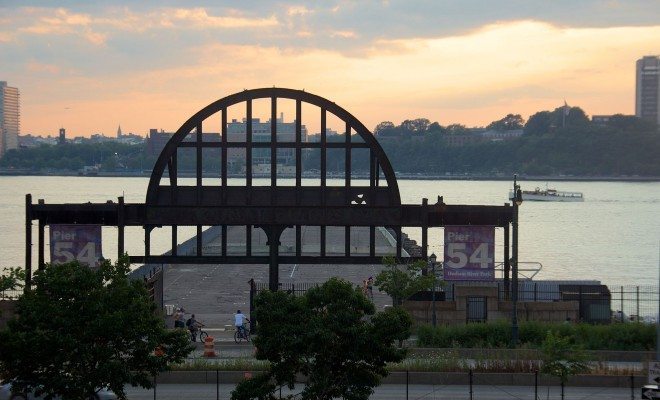 Image courtesy of [Mike Peel via Wikipedia]
Image courtesy of [Mike Peel via Wikipedia]
Energy and Environment
Hudson River Park Development in NYC Raises Questions
Lower Manhattan is a landfill. Composed largely from earth excavated during the subway construction process, it is an unnatural geographic feature and prone to flooding, as Superstorm Sandy demonstrated. In the ominous projections regarding melting ice caps and rising sea levels, it is one of the first places predicted to be inundated. In the 21st century, new plans to expand New York City continue to raise concerns and are questioned by environmental groups, as exemplified by the proposal for the offshore Hudson River Park, dubbed Pier 55.
Former head of Paramount Pictures and Fox, billionaire Barry Diller, is the primary promotor of this project and has pledged over $130 million to its construction. The 2.4 acre park would include concert venues, restaurants, walking and bicycling paths, and lawns. It would sit on a series of pillars standing between 15 and 70 feet above the surface of the water.
Many people are concerned, however, with the opaque manner in which the project is being pursued. Many details have yet to be disclosed to the public and to organizations that have raised concerns, raising questions as to the motivations for the park and the nature of its accessibility. That is to say, private control of public space is a contradictory concept and inhibits the true nature of an area that is apparently intended to be for the enjoyment of the people.
Furthermore, environmental groups are highly concerned as to the ramifications of the park, which would be built in a part of the Hudson River that is a marine sanctuary and spawning ground for striped bass. The Hudson River conservation organization Riverkeeper is worried that driving down pylons could disturb sediment and that the shade cast by the park would affect the behavior of fish and ecosystem dynamics. Yet the trust claims that the height of the park, facilitated by the use of the pillars, would allow for sunlight to reach the water. Furthermore, this park would not entirely be a brand new piece of construction dropped down in the middle of the water. Rather it is to be placed in large on the site of the previous Pier 54, which was once a dock for ocean liners including the Lusitania but has since fallen into disrepair and is collapsing into the river.

The Cunard Line’s arch at Pier 54. Courtesy of jim.henderson via Wikipedia.
Pier 55 requires approval from the Army Corps of Engineers and the New York Department of Environmental Conservation before construction can begin as scheduled in 2016. Yet these reassurances fall somewhat flat considering the knowledge that the trust submitted an environmental assessment form as opposed to a full environmental impact statement. While it points out that its report contained over 200 pages, it nonetheless had fewer requirements to answer. This ties into the opacity of the project, raising suspicions.
Diller was the primary benefactor of the High Line as well, another project that converted decaying urban space into productive real estate for the enjoyment of the public. Plans to build a Low Line park underground at the previous site of a trolly terminal on the Lower East Side have so far been met with much excitement. On the surface, Pier 55 seems like an altruistic and productive idea. But the fact that it is indeed on the surface raises a new set of concerns. Building in the water is far more complicated that revamping an old site on the land. The dialogue needs to be more productive before this project gets started; hopefully in the months to come questions will be answered and all parties involved will be reassured that this plan will work. The pier seems like a good idea and looks like it will be a fun place to visit once it is completed; as long as it does not inflict environmental damage, hopefully it will come to fruition.
You can check out more information and see a photo gallery of the proposed Pier 55 plans by clicking here.








Comments